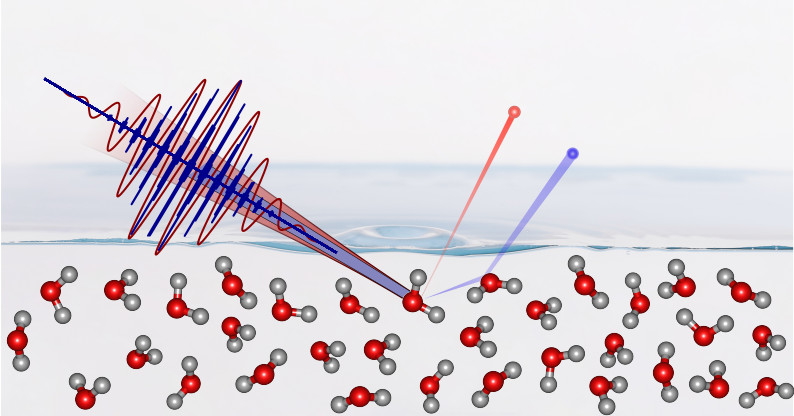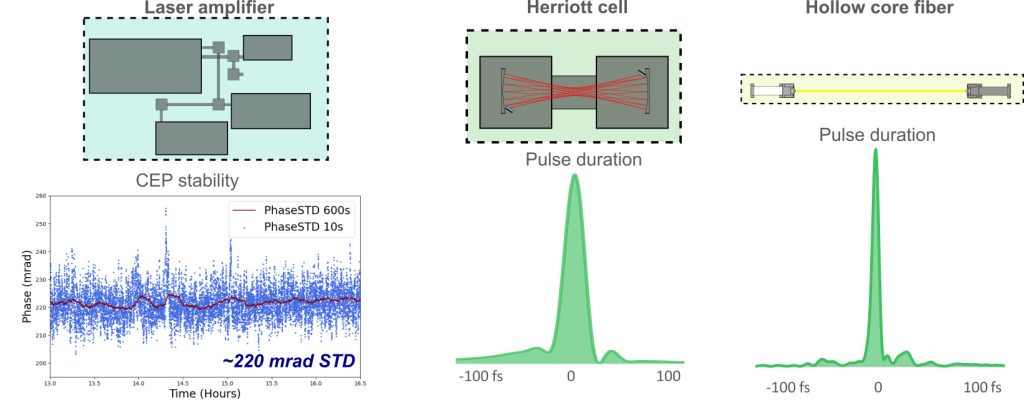Introduction
The aim of our research is to study the fundamental principles governing molecular behavior in complex media, with a view to controlling them.
While the dynamics of nuclear motions can be studied via femto- or pico-second spectroscopies (10-12 – 10-15 s) that have been in use for several decades, the study of electronic motions on the attosecond time scale (10-18 s) is only just beginning. To do this, we use the shortest laser pulses available, revealing the fastest phenomena ever measured by man.
In our laboratory, we use two types of attosecond spectroscopy to study two aspects of the dynamics of liquid water and solvated molecules.
Attosecond photoionization spectroscopy in the liquid phase
When an electron wave packet propagates in a potential, it is either accelerated or slowed down, depending on the nature of the interactions it undergoes, compared with a free wave packet.
Measuring this delay is a unique probe of the scattering potential.
In isolated molecules, we use this observable to probe the potential from which the electron is “born”. In the liquid phase, this diffusion can take place once the electron has been released.
Read more
We therefore aim to study fine electron scattering at different kinetic energies using a “RABBIT” protocol developed in the laboratory and so far used mainly on isolated systems.
Electron scattering in water is a key fundamental process in many fields, from quantum chemistry (for the evaluation of theoretical models) to radiotherapy (for the production of cytotoxic radicals).
Experimental techniques: ultrafast laser, charged particle detection, complex data analysis.

Liquid-phase attosecond transient absorption spectroscopy
The photoemission spectroscopy used in RABBIT measurements (see above and gas phase) provides information on the dynamics of the electron emitted by the excited system. To follow the electron dynamics from the point of view of the excited system, we are developing a new attosecond transient absorption spectroscopy instrument.
In these experiments, an isolated attosecond pulse resonantly excites our sample. By manipulating the system response with a second pulse of a few femtoseconds, we can trace the dynamics of the excited states and manipulate the frequency response.
Thanks to this tool and its application in the liquid phase, we aim to study the dynamics of solute/solvent charge transfer taking place in just a few femtoseconds.
In particular, we aim to manipulate molecules to modify (and enhance) their spectral response. To this end, we use non-linear optical protocols, such as wave mixing, to study chiral and non-chiral systems.
Progress
The construction of this experiment requires the completion of several steps, ranging from the post-compression of a stable laser in CEP phase to the creation of stable nanoscale water sheets in vacuum.
We have already demonstrated the post-compression of our 350-8 fs laser in two stages, one in a Herriott cell and the other in a hollow fiber (in collaboration with the SLIC group).


In parallel
We are also working on the synthesis of nanometric-thick sheets of water that can transmit the attosecond XUV pulse and are compatible with bio-relevant samples.
Experimental techniques: Ultrafast optics, microfluidics, vacuum technology
Associated project: ERC Starting Grant SATTOC


